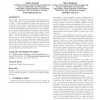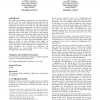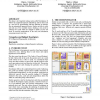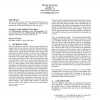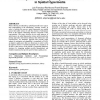HT
2005
ACM
14 years 2 months ago
2005
ACM
We describe the integration of smart digital objects with Hebbian learning to create a distributed, real-time, scalable approach to adapting to a community's preferences. We ...
HT
2005
ACM
14 years 2 months ago
2005
ACM
Recent theories of hypertext usefully emphasize continuity with earlier media; but in the general social environment, this continuity is not well understood, and may even be oppos...
HT
2005
ACM
14 years 2 months ago
2005
ACM
HT
2005
ACM
14 years 2 months ago
2005
ACM
Hypertext can be seen as a logic representation, where semantics are encoded in both the textual nodes and the graph of links. Systems that have a very formal representation of th...
HT
2005
ACM
14 years 2 months ago
2005
ACM
The technical and competence requirements for writing content on the web is still one of the major factors that widens the gap between authors and readers. Although tools that sup...
HT
2005
ACM
14 years 2 months ago
2005
ACM
Tasks that take place over a long period of time or collaborative tasks where participants are required to develop an understanding of each other’s effort benefit from better co...
HT
2005
ACM
14 years 2 months ago
2005
ACM
This demo is of a hypertext reading system called StorySpinner. It follows the sculptural hypertext methodology and has been used as a test bed for experimenting with the authorin...
HT
2005
ACM
14 years 2 months ago
2005
ACM
This paper describes the StorySpinner system, a sculptural hypertext reader used as a test bed for experimenting with the authoring of narrative flow in automatically generated st...
HT
2005
ACM
14 years 2 months ago
2005
ACM
HT
2005
ACM
14 years 2 months ago
2005
ACM
When reflecting on information, spatial hypermedia users express their understanding of the information’s structure visually. In order to facilitate this process, spatial hyperm...

